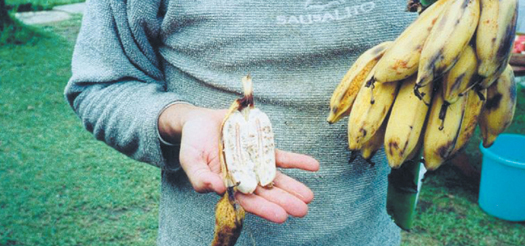
Some philosophers, such as the great writer, translator, and thinker Edmond Bordeaux Szekely, believed humans were once a frugivorous creature, but have been altered due to centuries of unnatural feeding. However, it is not humanity’s biological form which has changed, it is the food itself, which has been altered and hybridized.
When the earliest humans first began cultivating crops and fruit trees, they unwittingly also began to protect these crops and fruit trees from natural selection (which, as we have seen in Lesson 9: Origins, does occur within a species, but cannot create a species). The cultivated crops were cross-bred for better taste, longer durability, stronger skins, etc., yet at the same time were growing genetically weaker as the unfittest strains were allowed to survive as long as they “tasted better” or “lasted longer.” Eventually, certain crops and fruit trees were grown for so long in protective environments (away from wild Nature) that they no longer had sufficient “genetic energy” to survive in wild Nature untended. These foods I have termed “hybrid foods.”
Hybrid foods are foods that will not grow in Nature. My colleague, Dr. David Jubb, tells us that hybrid foods are “missing vital electrics.” They are foods, which must be nurtured and protected by humans, or else they will be overcome by birds, insects, worms, fungi and bacteria.
Most fruits sold in large supermarkets are cross-bred and hybridized to some degree, but are still excellent foods; often they are still capable of reverting back to a wild or semi-wild state. Fruits, such as avocados, cherimoyas, jalapeno peppers and tomatoes are great examples of these. As a general guideline, fruits which have been hybridized too far include all seedless fruits or fruits with non-viable seeds. These fruits should be avoided, because they are genetically altered and weak.
Also, grafted trees produce awkward fruit, often without seeds. Grafting is a process apparently developed by the Chinese, whereby one variety of fruit tree is united to another variety of the same fruit tree. Many varieties of orange trees are actually two trees in one. The root stock is of a totally different variety than the stem and branches. Again, focus on the seeds; if they do not exist, or are not viable, then avoid those foods.
The biblical verse Genesis 1:29 actually warns of the danger of hybrid foods. The verse advises us to eat only herbs bearing seed and fruits bearing seed.
Seedless foods are so hybridized they can no longer reproduce. The inability of hybrids to reproduce stems from a deficiency in the procreative cells. Hybrids can lack a double set of chromosomes in their reproductive cells, and this leads to the inability to produce viable seeds.
Common hybrid fruits, grafted fruits or fruits grown from cuttings include: seedless apples, bananas, most common date varieties, kiwis (their black seeds are not viable), seedless pineapples, seedless citrus fruits, seedless grapes (raisins), seedless persimmons and seedless watermelons.
The standard bananas we all know are excessively hybridized foods. I was raised on bananas and this was difficult for me to accept. The black “seeds” found in the common banana are not seeds at all, but are non-viable remnants of what should be semi-hard, pellet-sized, walnut-tasting seeds. I transitioned away from bananas by eating fewer and fewer until I finally let them go.
Hybrid fruit is not only unnaturally high in sugar, but is also low in minerals. I have noticed that I can eat super-sweet wild berries in massive abundance and get no unusual reaction or high at all. I have also noticed that if I eat a mildly sweet hybrid fruit I get a “weird” reaction from just a small amount — seedless grapes send me into “la-la” land (sugar high).

A real non-hybrid banana with seeds that I found while in Bali, Indonesia. This type of banana is so filling that it is difficult to eat more than one.
Hybrid foods are devoid of the proper mineral balance all wild foods contain. Excessive hybrid fruit consumption leads to mineral deficiencies. It is not only that hybrid fruits and sweet/starchy vegetables (carrots, beets, potatoes) themselves are unbalanced in minerals, it is that an overconsumption of hybrid sweet fruit and sweet/starchy vegetables causes the body to bring heavy minerals from the bones into the blood to buffer the hybrid sugar, which is not completely recognized and dealt with by the liver and pancreas. The minerals and the sugar are then spilled off into the urine. So, in the long-term, hybrid sweet fruit and sweet/starchy vegetables can actually overstimulate you, causing you to lose minerals.
Common hybrid vegetables include: beets, carrots, corn and potatoes.
Most of the vegetation people eat is not found growing wildly in Nature. The fields in which they grow are protected from natural forces. The natural insects are poisoned with pesticides, the soil microbes are poisoned with fertilizers. Crops grown chemically are artificial — their cultivation is unnatural.
Common brown and white rice varieties are hybrids. Commercial oats, barley and wheat are hybrid plants.
Common, controversial alfalfa sprouts (often criticized for containing toxins) are hybrid foods. Clover sprouts are a better, more natural choice and should be chosen over alfalfa.
Most commercially available legumes are hybrids. I once grew lentils from seeds in wild “survival of the fittest” fashion. Only one out of hundreds grew to fruition. When I harvested the lentils from that one plant, each lentil displayed an amazingly beautiful design on the seed surface — totally unlike the dull orange/brown lentils available from the store. Amazingly, the lentil plant had reverted back to its natural, wild state!
Many primitive peoples, and all wild primates, eat foods from at least 100 varieties of plants. The majority of the world’s population now, on civilization’s various diets, consume only 13 varieties of plants: bananas, beans, beets (beet-derived sugar), corn, oranges, potatoes, rice, wheat, soy beans, sugar cane, sweet potato, cassava and coconut. The first 9 of these 13 listed are such hybridized foods (or genetically modified) that they are either seedless or produce seeds incapable of surviving independently in Nature. Due to the deficiencies of nutrients in hybrid foods, this situation presents an enormous health challenge for the world; and yet, it also presents a tremendous opportunity to improve the health of the world.
People become addicted to bread, corn chips, french fries, baked potatoes, and even carrot juice, because these foods come from hybridized plants that contain an addictive quantity of sugar and a low-level of minerals.
I have noticed that hybrid foods are attacked by different forms of fungi than wild food. Hybrid foods are much more susceptible to early decay. For example, I can have extremely hybridized yellow seedless grapefruits outside in my back patio in the Sun alongside seeded ruby red grapefruits. The ruby reds (though not a wild strain) will last months out there as they ripen to perfection (citrus ripens best in the sun, on the ground), however, the yellow seedless grapefruits will be overcome by bright to dark green mold outlined by white. You will never see this type of mold attack a wild fruit.
From these types of observations, it is clear how hybrid fruit can feed fungal conditions in the body, such as candida. Whereas non-hybrid or wild fruit does not trigger such a condition.
How To Make Hybrids Work For You
Hybrid foods are everywhere and most of us still need to eat something! It is possible for you to make hybrid foods work for you. The effects of hybrid foods on the body are usually not felt physically or consciously until one is significantly purified after many months and years on a pure diet.
Remember: start where you are now. When I started on raw foods I was probably eating 90% hybridized food. My health dramatically improved when I shifted my choices. I realized that I could not thrive on hybridized foods, grafted foods and foods grown from cuttings. Over time I learned to fine tune my diet and body to achieve an extraordinary level of health.
Hybrid fruits and vegetables may be eaten in small amounts. Mixing bananas with fat (avocados, nuts, olives) lessens the sugar effect of that fruit on the system. Eating more green-leafed vegetables and avocados, nuts, or olives with hybrid sweet fruits or vegetables will decrease their effect on the blood sugar and increase the utility of elements in the food. Hybrid grains may be eaten straight or sprouted.
Even if hybridized, whenever possible eat food grown locally, indigenously under the Sun, under truly organic conditions.
Eat food that is in season. I have noticed that I can eat dates in abundance (up to 30 in a day if I am extremely active) when they are in season (fall and winter). But when I eat dates out of season, they give me a strange reaction similar to the feeling of eating too much hybrid fruit and I cannot even eat two or three dates.
Importantly, non-hybridized wild foods are available when you look closely. These valuable foods include: all seaweeds, blue-green algae, wild bee pollen, wild honey, and, of course, all food substances found growing wildly in nature.

1 Identify the hybridized foods (raw or cooked) in your diet. Decide to replace these foods with more natural foods as soon, and as often, as possible. Particularly watch out for foods high in sugar and low in minerals.
2 The solution to hybridized food? Grow your own food from heirloom seeds (contact heirloom seed banks through the Internet). Also, whenever possible, eat wild plants and fruits.
3 Participate in a hands-on class — in the field — with a local herbalist.
A magnificent Kirlian photograph of a wild malva leaf. Malva leaves are one of Nature’s great delicacies.
